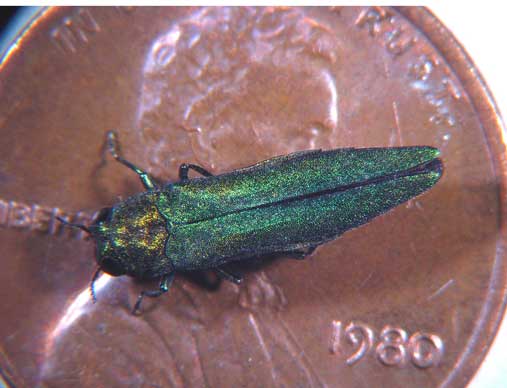
Although it is smaller than a penny, the emerald ash borer has the potential to do a lot of damage in Kansas City.
Posted by Joe Lambe
In a decade, the invading emerald ash borer spread from Michigan to Platte County and killed millions of ash trees along the way.
Officials think it is already in Jackson County and probably in Midtown and they are acting to slow destruction that seems as unstoppable as Sherman’s march to the sea.
Platte and Clay counties are now under quarantine along with six counties in southeast Missouri, the Missouri and U.S. departments of agriculture announced last week.
That means that Kansas City will have to set up a new center to dispose of yard waste and brush north of the river, said Kevin Lapointe, city forester. Currently brush from there goes to Jackson County for disposal.
Wood products like hardwood firewood or any ash product or tree cannot be taken from the quarantined counties without special permission.
Lapointe said it would help the containment effort if Jackson County were included in the quarantine but they have not found the borer here despite months of searching.
Wendy Sangster, a forester with the Missouri Department of Conservation, said “We looked hard in Jackson County – I still think it is there.”
Part of the problem is they did not have bucket trucks to look at the tops of trees where the borers start feeding, she said.
Experts estimate there are up to 7 million ash trees in the nine-county metro area. Cities planted them to replace trees killed by the Dutch elm disease and developers used them to shade entire subdivisions.
Lapointe said that Kansas City has only about 20,000 of them planted along roads but developers have planted many times that number.
He will prepare a plan soon for the City Council on how to slow the attack, he said. Quality elm trees in Jackson County and elsewhere should be sprayed with insecticide to slow the borer, he said, not that the bugs can be stopped.
Sangster said to enjoy the ash trees this fall.
“They’re looking really pretty right now, turning purple,” she said. “They seem relatively healthy, but not for long.”



Trackbacks